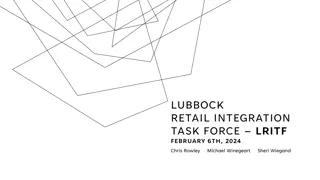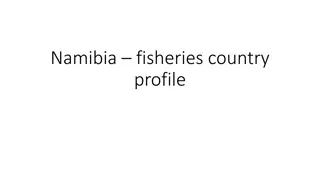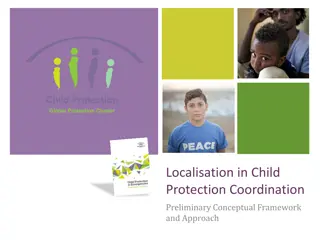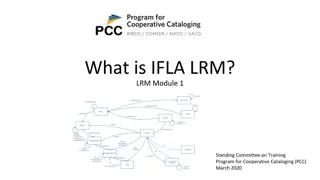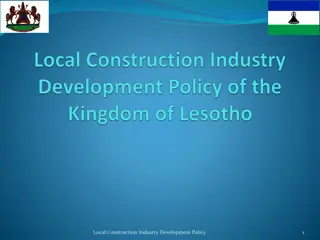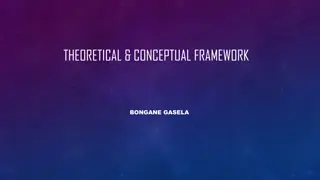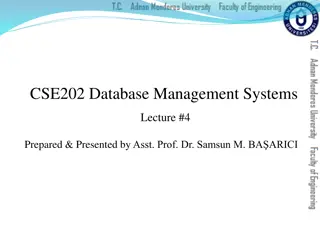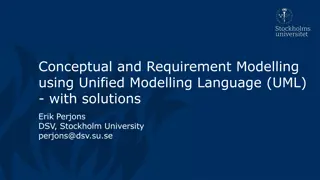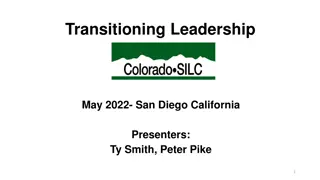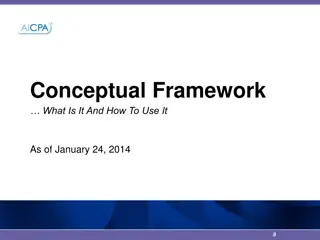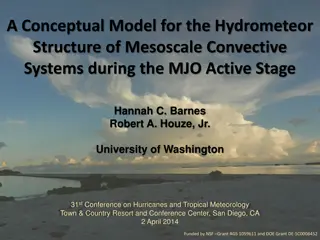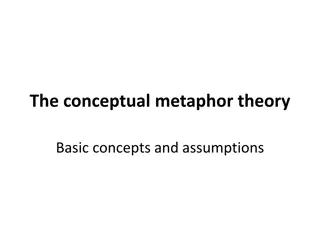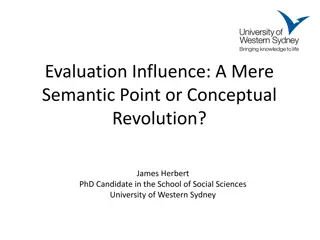Local Productive Systems Transitioning to Industry 4.0+: A Conceptual Framework
A conceptual framework explores factors influencing local productive systems (LPSs) transitioning to Industry 4.0+, emphasizing sustainability models vs. technocratic approaches. It delves into challenges of digital, social, and green transitions, advocating for innovation systems and cross-domain partnerships. The discussion highlights Industry 4.0+ as an alternative model for fostering growth, prosperity, and sustainability within EU economies. The Makers Project, focusing on smart manufacturing, offers insights on leveraging I4.0+ to empower SMEs and drive systemic change toward decentralized, specialized, and innovative local systems.
- Industry 4.0
- Local Productive Systems
- Sustainability Transitions
- Innovation Systems
- Smart Manufacturing
Download Presentation

Please find below an Image/Link to download the presentation.
The content on the website is provided AS IS for your information and personal use only. It may not be sold, licensed, or shared on other websites without obtaining consent from the author. Download presentation by click this link. If you encounter any issues during the download, it is possible that the publisher has removed the file from their server.
E N D
Presentation Transcript
Local productive systems transitions to Industry 4.0+ Marco Bellandi (presenting) and Lisa De Propris ACU ROME 2022 14 November 1
SUMMARY A conceptual framework on factors promoting or hindering local productive systems (LPSs) to transition onto models of sustainability: Alternatives to technocratic models of Industry 4.0; How an alternative model, Industry 4.0 plus (I4.0+), might enter possible sustainability transitions of LPSs Digital, social, and green challenges of such transitions Need for support from innovation systems and multi-domain partnerships operating at different territorial levels Conclusions on system innovation policies 2
Alternatives to technocratic models of Industry 4.0 At the core of the contemporary wave of technological change: Industry 4.0 EU definition: It overlaps with a huge set of other digital-based or digitally supported new technologies and products (FIR). Efficiency driven arguments TECHNOCRATIC AND MONOPOLISTIC MODELS Smart and webbed factories almost without workers Expansion of the autonomy of machines and reduction of skilled labor Mass customization & Lower inventory upstream, in process, and downstream All organized along global value chains controlled by large MNEs
Alternatives to technocratic models of Industry 4.0 Do exploration and exploitation of I4.0 potentialities need polarization of knowledge, decision-power, capital, industries, and places? This would seem to be implied by the efficiency-driven arguments in that case what about the diffusion of growth & prosperity or Is a variety of solutions possible? some consistent with virtuous circles between parts of I4.0 potentialities and a wide mobilization of human capabilities: joining technologies, new and traditional industries, large populations of skilled workers and good jobs, a fair distribution of income opportunities, room for bottom-up creativity in production processes, products, and society, and environmental sustainability this is what in the MAKERS project has been called Industry 4.0 plus (I4.0+) 4 MAKERS - Smart Manufacturing for EU growth and prosperity is a project funded by the Horizon 2020-MSCA- RISE - Grant agreement number 691192.
Alternatives to technocratic models of Industry 4.0 I4.0+ implies considering the opportunities for change for millions of SMEs populating the European economies and other areas: They host a lot of innovators, but SMEs are constrained by uncertain markets and finance and, singularly, a small set of internal skills; Independency from command and control of monopolistic concentrations supported by systemic characters: Endog eneity Special isation De- centralisati on (a) local productive systems (LPSs) featuring place- based specialisation, endogeneity, decentralisation (b) related local and regional innovation systems and cross-domain partnerships for innovation Putting I4.0+ solutions at the core of an LPS implies rerouting to a new path of development - path change. Given the interrelation of digital-social-green dimensions: rerouting as sustainability transition 5
I4.0+ and LPS sustainability transitions Models of sustainability transitions (Geels, 2011): An innovation gap facing complex/wicked problems of environmental sustainability - not just a new product or a new technology but multi- dimensional innovation and structural change sustainability transitions Niches socio-tech regimes landscapes Place-based applications of sustainability transitions: the multi-level structure (niche emergence, niche experiments, selection, transformation of socio-technical regimes) is multi-territorial . niches developing in specific local systems, and expansion by docking in increasing sets of production, innovation, and territorial systems. Local systems of sector specialisation Mature technology regime New technology regime Local incubators of new technologies The sustainability transition to comprehensive I4.0+ solutions in an LPS may follow different routes 6
I4.0+ and LPS sustainability transitions An ideal representation of transitions towards or away from full I4.0+ in LPSs starting from different partial I4.0+ states Bellandi & De Propris (2021) Hypothetical initial states of two ideal types of well-grown LPSs, depending on their core specializations and know-how: Quadrant IV: LPSs characterized by a pool of differentiated natural and cultural resources (e.g., bio-economy specializations, tourism districts, etc.), being associated more easily with bio- and cultural paths. Case I Quadrant II: LPSs characterized by highly automated processing (e.g., mineral based products and mechanical industries, ICT clusters, etc.). Case II 7
I4.0+ and LPS sustainability transitions Case I. Leather district of Arzignano A certain level of technological dynamism: to assure the highest quality to the leather and to fight local environmental impacts. The role of green / social drivers: key role of the network of local firms and of the traditional relational governance structure emerges: the approach towards sustainability has also been influenced by the command & control measures of the authorities and by strong institutional support [Da Ronch, Di Maria, Micelli, 2013, p. 46]. Yet, the penetration of automatization tends to be slowed by the natural lack of uniformity of the main raw material (animal hides). Testing graphene within the tanning process, prolonging the life of leather to 40-50 years High level of investments in collective purifiers of industrial water and waste Focus on a green transition, and slow integration of digital (De Marchi, Di Maria, 2019). The route to a comprehensive I4.0+ model possible but retrogressive paths not excluded Il Sole 24 ore 2022-09-01 p.16 LA.CONCERIA.IT 2014-12-04
I4.0+ and LPS sustainability transitions Case II. Ceramic district of Sassuolo High technological dynamism led by a tradition of automation & medium-to-large firms together with collective innovation. Digital drivers integrate environmental problems: New plants with high throughput, high energy efficiency, and new products a bottom-up approach to facing environmental pressures, in which leading firms play a fundamental role in the evolution of the whole district, with a cooperative approach among different actors [Da Ronch, Di Maria, Micelli, 2013, p. 46]. Il Sole 24 ore 2022-13-01 p.20 Cooperative approaches and territorial servitization help contrast the dominance of technocratic digital approaches. Thanks to bottom-up and cooperative approaches, greening tech and local environment care are diffusing (Garcia-Mui a et al. 2018). Il Sole 24 ore 2022-09-08 p.23 use of renewa ble energy and reuse of waste With leading digital and economic drivers integrating green and social drivers, transition to a full I4.0+ model seems probable 9
Digital, social, and green dimensions The concepts of I4.0+, sustainability transitions in LPSs, and the two cases illustrate the need of going deeper into the factors of LPS sustainability transitions. Drivers and barriers (a) a new centrality of manufacturing specializations combined with a cloud of specific knowledge-intensive digital and green services; (b) as well, deep conflicts and barriers the status quo at local levels and the threats posed by globally dominant models. Challenges (c) how social and economic actors create value and experiment with new models of value capture and redistribution; (d) how digital and economic drivers and barriers combine with green ones Illustration by means of 4 challenges
DRIVERS Interdependent new know-how nuclei within and around smart micro-manufacturing Control of closed loop processes, green products as services, waste is wealth (a,b) BARRIERS New transaction costs on crucial information; digital platforms of large firms Digital supported control of delocalization of phases of high environmental risk (c,d) CHALLENGE 1 Digital with Green The cross- fertilization of green and digital technologies From smart networked micro-manufacturing within multi-scalar networks of digital services providers, designers, and prosumers, to: (a) Collective innovation applying digital solutions to greening the industry (e.g., in the circular economy CE); (b) CE gives digital technologies an enormous field of local applications Low-cost linear alternatives and technocratic control of platforms: (c) Solutions that pursue I4.0 without CE would deliver further cycles of unsustainable economic growth; (d) Delocalization of phases of production/recycling that have heavy & irreducible environmental impacts; leaving in the advanced countries the greener phases & greenwashing 11
DRIVERS BARRIERS CHALLENGE 2 Neo-makers driving a personalized use of cyber-physical tools From skill polarization, and lack of investments on new digital competencies Till the exploitation of informal workers in recycling dumpsites (c,d) Digital with Green Neo-makers and workers skilled in support to ecosystem services Digital powered skills in operations on environment and production fields (a,b) An open organization of a multiplicity of actors combining operative well- trained skills with digital based and environmental sustainability: (a) Neo-makers and workers who operates at the interface between environment, phases of production, and use of products (b) Creative interpretation of consumer needs and personal knowledge of the environment, alleviating riskier and dirtier jobs In the technocratic model: (c) A combination of distant control rooms and distributed sensors with the use of workers on the field for quite unqualified service jobs; (d) Till the outsourcing of recycling to delocalised dump sites with armies of informal workers 12
DRIVERS BARRIERS CHALLENGE 3 Distributed provision of KIS and territorial servitization for SMEs Digital-based dominance of big players within global value chains Digital supported monopolistic/illegal control of natural resources/sinks (c,d) Digital with Green Economic bases of capture of green and digital value Industrial symbiosis, waste management 4.0, shared green and digital value (a,b) The capability of LPSs to capture the value created within the system and distribute it sustainably depends also on: (a) Corporate responsibility on social & environmental issues within collective projects of shared green and digital value; (b) Territorial servitization and digital urban tech as a place-based countervailing power that enables shared green and digital value. Private capture of the collectively produced value is extended by the digitally supported monopolistic (also illegal) control of: (c) Large platforms managing global value chains (d) Sources of natural resources, and waste sites 13
DRIVERS BARRIERS Digital divides, smart cities led by big digital players and surveillance Gated cities and predatory disposal of waste in non-protected areas (c,d) CHALLENGE 4 Multilevel innovation systems & quintuple helix partnerships for shared digital and green value Democratic bases of digital transformation Digital with Green Need of integrating ecosystem agency in sustainability transitions (a,b) The cross-domain nature of LPS sustainability transitions: (a) They are necessarily about interactions between technology, policy/ power/politics, economics/business/markets, and culture/discourse/public opinion (Geels, 2011, p. 25) (b) they demand the operation of multi-level institutions involving multi- domain innovation partnerships, viz. Quintuple Helices (5Hs) Smart cities led by big digital players, surveillance approaches, and globally monopolistic districts: (c) Gated communities of sheltered well-offs; (d) Predatory disposal of waste in non-protected areas by powerful actors capturing local governments and using illegal/criminal channels 14
Multi-scalar innovation systems and 5Hs A place-based approach Consider the socio-territorial context of an LPS where history has accumulated factors of innovation systemness (Leydesdorff 2021, p. 118-119): a common nexus of local cultural heritages, civic attitudes, and environmental experiences of local communities (Becattini, 2015) oriented to the active involvement of resources and actors in processes of knowledge sharing addressing combinations of business, social, and environmental innovations. Such an LPS intersect a local innovation ecosystem (LIE) (Boyer, 2020): led by multi-domain networks and partnerships, from THs (Leydesdorff, Etzkowitz, 1998) to Quintuple Helix models (5Hs) (Carayannis, Campbell, 2019): specifically, with 5Hs, exploiting learning & boundary spanning function, where shared experiences help value creation & capture. 15
Multi-scalar innovation systems and 5Hs In a full-fledged 5H model Each type of actor not only exchanges with other types but also can enter the role of other types in circular interactions of knowledge hybridization Civic actors include media, creative, and cultural agents, NGOs, etc (Carayannis and Campbell, 2009) Ecological actors include agents of territorial infrastructures, natural resources & waste management, disaster management, some functions in food value chains etc. Innovation Ecosystem and Quintuple helix actors and processes Value creation in markets Public regulation Novelty production Industries HEIs and PROs Governments Civic actors Ecological actors Environmental sustainability Democratic participation 16 Bellandi, Donati, Stefani (2022)
Multi-scalar innovation system However, not necessarily an LPS whose LIE s properties are not strong enough for supporting the transition to a comprehensive I4.0+: the need for systemness and innovation partnerships at higher territorial scales Regional/local systemness direct support for the sharing of more tacit/contextual information and analytical/place-specific symbolic knowledge according to DUI modes A: RIS without LIEs, helical processes closed by cross-local and regional actors B: RIS with an LPS/LIE playing as a pivot for local and regional helical processes Opportunities and variety of cross-fertilization and more radical innovation included in a national setup hosting large research infrastructures, financial networks, complementary productive capabilities mission-oriented approaches Factors of systemness at the national level necessarily more fragmented direct support for sharing of analytical/distanced symbolic knowledge - STI modes. COMPETITIVE ADVANTAGE ON KNOWLEDGE MIXES Analytical/ distanced symbolic knowledge/ STI modes NIS RIS Territorial innovation systems LIE Territorial learning systems Synthetic/place specific symbolic knowledge/DUI modes
System policies for innovation and development in the age of I4.0 Multi-territorial policies are more necessary than ever. The local level is still fundamental But more intertwined with dynamics that take place on larger territorial scales across different local systems: the need for initiatives contributing to or providing specific public investments and goods, such as: a) Guidelines to target strategic investments in innovation at the national and European levels (national and EU champions) and at the regional and local levels (e.g., from S3 to S4+ McCann and Soete, 2020); b) Coordination inputs, reduction of systemic uncertainty, and guidance for constructive place-leaderships against local rent-seeking or technocratic non-local organizations; c) Intermediary agencies supporting national, cross-regional and regional/local networks of innovation, managing trade-offs and complementarities between STI and DUI-based networks; d) Technological platforms that enable combinations of socio-technical and socio-ecological approaches. 18
THANK YOU marco.bellandi@unifi.it l.depropris@bham.ac.uk PRESENTATION BASED ON THE PAPER PUBLISHED ON Sustainability 13, no. 23: 13052. https://doi.org/10.3390/su132313052 19












